This concerns film that feature outbreaks of plague and disease as depicted in genre cinema. This falls into roughly three groupings:-
– Films About Outbreak and Pandemic – these chart the release of viral agents and the way in which they spread and the socially catastrophic consequences that result
– Films About Biowarfare Agents – these are more concerned with potential release of deadly biologicals such as thrillers set around the recapture of stolen agents or threat of their use, or else the hunt for infected individuals
– Films Set in Plague Devastated Futures – this concerns worlds where civilisation has been devastated or reduced to ruins in the aftermath of an outbreak
– Films About Real World Pandemics – this concerns depictions of plagues that have affected the real world such as the Black Death and the Corona Virus pandemic of the 2020s in a fictional context
Epidemic and Outbreak
It is not certain what the first film was to depict an epidemic (an outbreak on a local or national scale) or pandemic (an outbreak across multiple countries). As far as one is able to tell, the first depiction of an outbreak was in the silent film The Last Man on Earth (1924), a comedy wherein a plague wipes out all men except for one man who remains alive and finds himself a prized commodity in a world of women.
The first major film on the issue of viral outbreak was Elia Kazan’s film noir Panic in the Streets (1950) with detectives and public health officials tracing an outbreak of pneumonic plague among the criminal underworld of New Orleans as it spreads.
The next big work was the Michael Crichton-adapted The Andromeda Strain (1971) concerning the efforts of scientists at a top secret US government facility to isolate and prevent the spread of an virus brought back from space by a returned NASA satellite that has wiped out a small Arizona town. The film is made with painstaking detail and is one of the few that shows the scientific process involved. This was later remade as the tv mini-series The Andromeda Strain (2008) where it was improbably revealed that the virus is an artificially intelligent, genetically engineered organism sent back in time from the future.
The basics of The Andromeda Strain were prefigured in the earlier Spacemaster X-7 (1957) about the manhunt for a housewife who is unwittingly spreading alien spores brought back from Mars. There was also the Doctor Who episode The Silurians (1970) where the title prehistoric dinosaur people release a virus to wipe humanity from the Earth that they regard as their natural home.
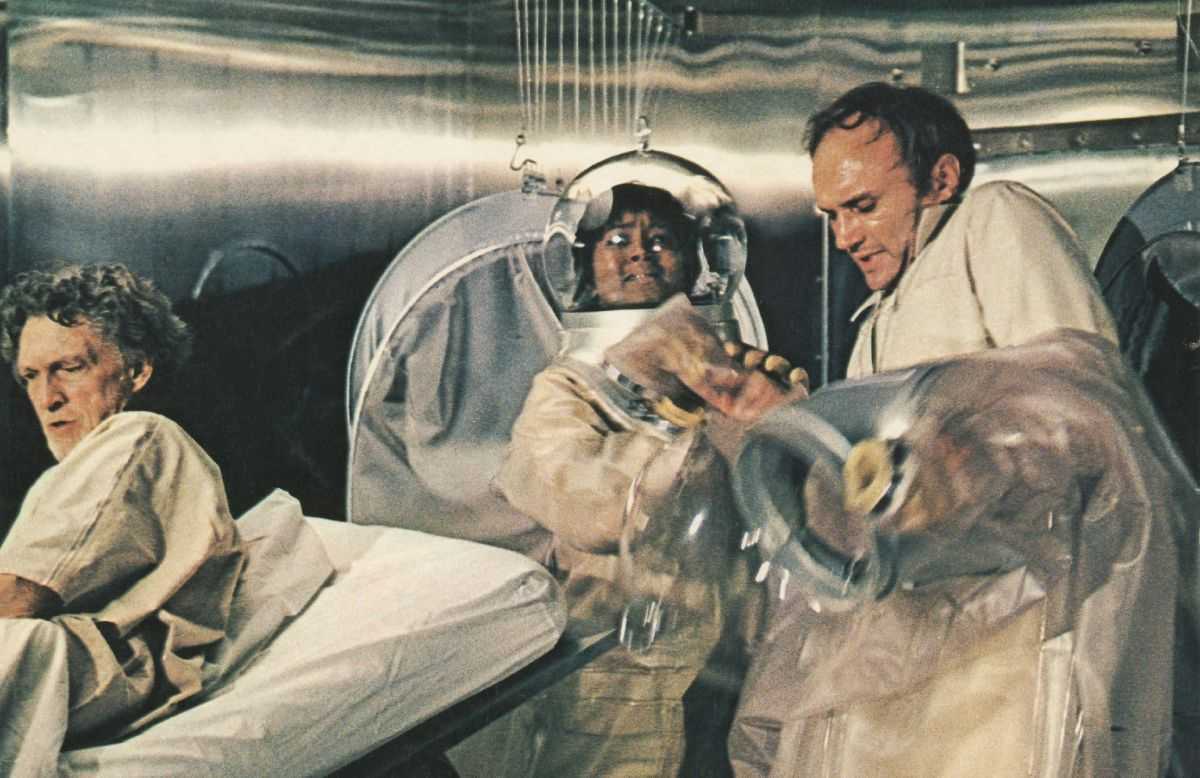
The disaster movie The Cassandra Crossing (1976) concerned a train full of people infected with a deadly plague, while Killer on Board (1977) concerns an outbreak on a cruise ship. Other films of this period concerning outbreaks include Rage (1972), Plague/M3: The Gemini Strain (1978) about the hunt for an infectee and the German The Hamburger Syndrome (1979).
The publication of the best-selling non-fiction book Crisis in the Hot Zone (1994) created a public fascination over Ebola. This led led to Outbreak (1995), a big-scale film that offered a dramatised depiction of the scare surrounding the widespread outbreak of an Ebola-like virus on US soil. This was followed a spate of works about outbreaks, which included the likes of the tv series The Burning Zone (1996-7) where scientists dealt with new viruses on a weekly basis and the films Virus (1995), the tv mini-series Pandora’s Clock (1996), Doomsday Man (1998), the Steven Seagal action film The Patriot (1998), Thirst (1998), Contaminated Man (2000), Venomous (2001), WW3 (2001), The Paradise Virus (2003) and Virus X (2010). The true-life story of the Ebola outbreak on US soil was later dramatised in the tv mini-series The Hot Zone (2019).
The work that has come to be regarded as standout on the subject was Steven Soderbergh’s Contagion (2011) about the worldwide effects of an epidemic – so much so that it was for a time the most popular Netflix title during the Corona Virus pandemic of 2020. There was also the large-scale South Korean film Flu (2013).
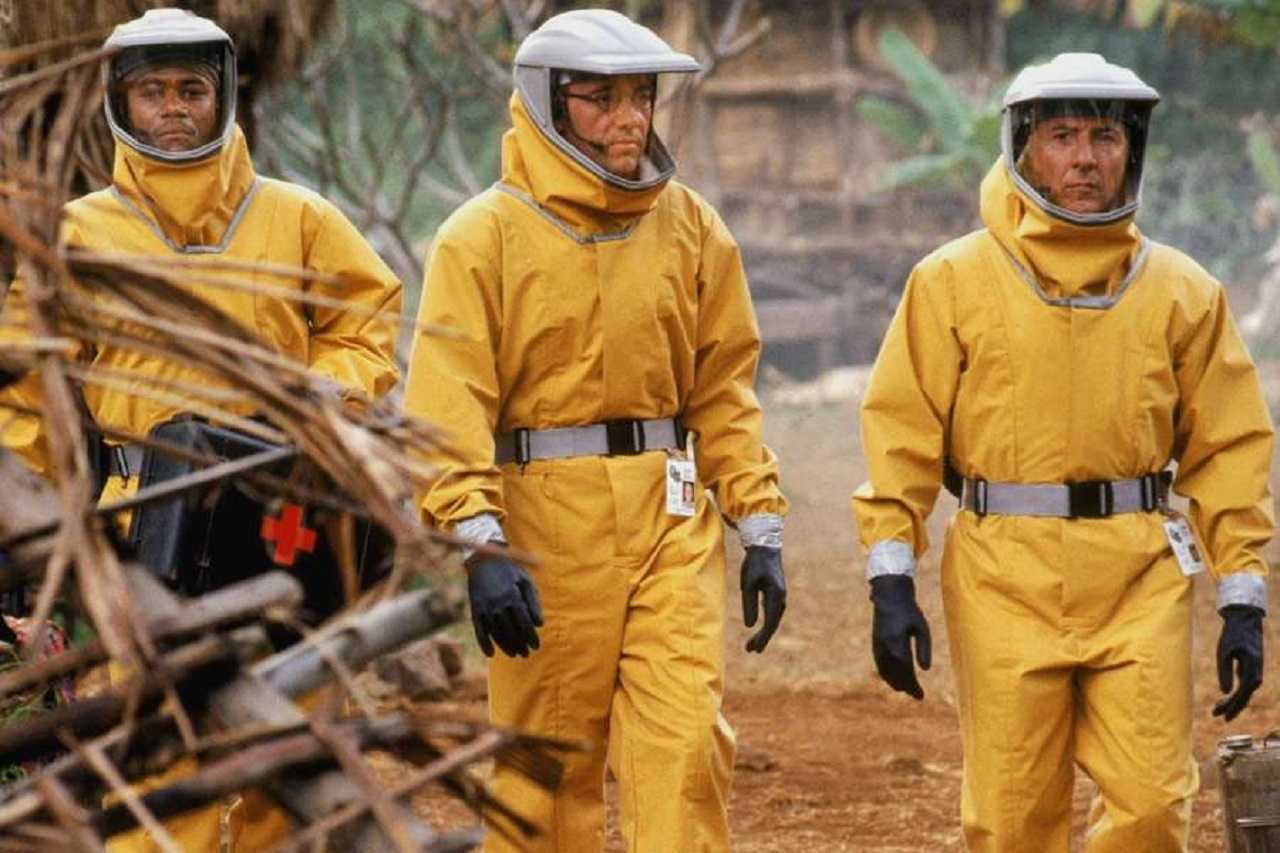
Other treatments include The Carrier (2015) concerning a planeload of people fleeing from an outbreak before finding they are carrying it on board, and Containment (2015) about a group of tenants waking to find themselves walled into their apartments as an outbreak occurs. The Bar (2017) features a group of patrons at a Madrid bar who turn to fear and panic as it becomes apparent that they might be infected following a biospill. Other films include the Venezuelan film Infeccion (2019), and the tv series’ Containment (2016) and Sløborn (2019). There was also The Plague (1992) adapted from Albert Camus’s allegorical novel about a South American city under infection.
Eli Roth’s Cabin Fever (2002) is a tongue-in-cheek splatter film that concerns a group of friends holidaying at a cabin on the woods, only to become infected with a deadly flesh-eating disease. This was followed by two sequels and a remake that depict the infection and people melting down with a great deal of gore. A similar effort was Contracted: Phase II (2015).
The World After a Pandemic
Several SF films postulate After the Holocaust/Apocalypse scenarios where civilisation has been destroyed by plague outbreaks. The first and best of these was the British tv series Survivors (1975-7) about the efforts of a handful of survivors to rebuild and maintain semblance of life after a pandemic kills off most of the population. This was far less effectively remade as Survivors (2008-10).
There was also the film Virus (1980) set in the aftermath of a worldwide pandemic. One of the strongest and bleakest of these was Carriers (2009) about a quartet of people journeying across country that has been ravaged by plague. The tv series The Last Man on Earth (2015-8) was a comedy tv series set in the aftermath of a viral apocalypse with Will Forte believing he is the title man before encountering other survivors.
The epic work on this subject was the Stephen King novel The Stand (1978) in which almost everyone in the world is killed off by the accidental release of a virus and the survivors are brought together guided by prescient dreams into two camps, one on the side of good, the other led by a demonic envoy, for a showdown between good and evil. This was poorly filmed twice as the tv mini-series’ The Stand (1994) and The Stand (2020-1).
In Doomsday (2008), all of Scotland has been walled off in order to contain an outbreak. The Terror Within (1989), Cold Harvest (1998) and The Lost Future (2010) are set among the survivors of plagues in post-apocalyptic worlds. Both Hidden (2015) and It Comes At Night (2017) are about families gathered in shelters from those outside at fear of infection.
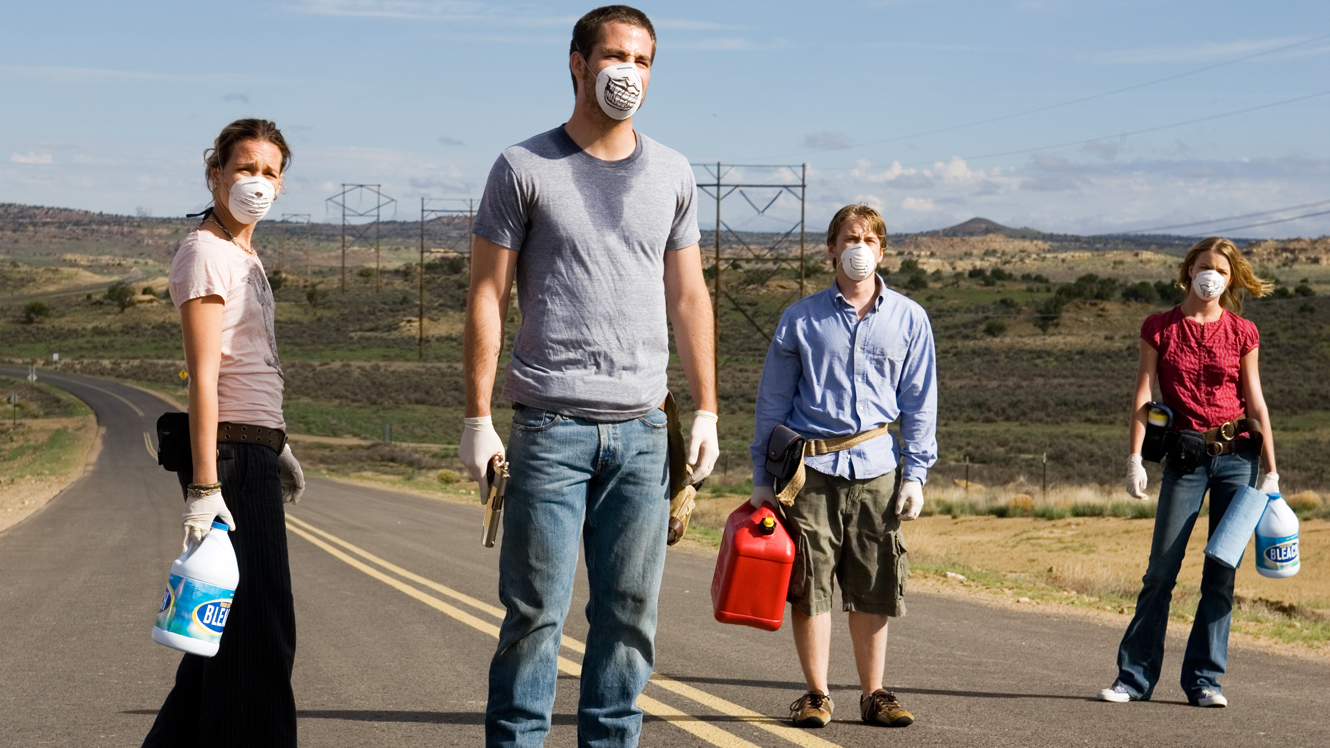
Both Light of My Life (2019) and Only (2019) take place in worlds where plagues have killed off all women and concern themselves with the last remaining ones. The tv series Y: The Last Man (2021) is set in a world where all men but one have been killed off, while the tv series Creamerie (2021- ) plays the same premise for comedy.
Riot Girls (2019) is set in a town where a plague has killed all adults. Conquest of the Planet of the Apes (1972) is set in a future where a plague has killed all cats and dogs. The tv series Sweet Tooth (2021- ) is set after a pandemic has caused a series of animal hybrids to emerge.
Twelve Monkeys (1995) has a man sent back in time from a plague-ravaged future to try and stop the outbreak only to end up causing it, while a similar plot was also used in Diverge (2016). Adrenalin: Fear the Rush (1996) features the hunt for an escaped infectee.
Other examples of plague-affected future plagues include The Last Chase (1980), The Lathe of Heaven (1980), Exam (2009) and War of the Planet of the Apes (2017), although it is not a primary element in these. Cyborg (1989), Johnny Mnemonic (1995), Barb Wire (1996), The Sector (2016), Flashburn (2017) and Supergrid (2018) are set in futures and concern efforts to find cures to infections.
The Black Death and Real World Outbreaks
Several films deal with the bubonic plague or Black Death and the Mediaeval vision of it. The Masque of the Red Death (1964), Masque of Red Death (1989) and The Masque of the Red Death (1989), adapted from the Edgar Allan Poe story, feature a group of aristocrats walled up in a castle from the plague ravaging the land, only to be visited by Death in person. In the silent German Faust (1926), we see The Devil deliberately infecting a town with plague.
In The Navigator: A Mediaeval Odyssey (1988), a group of Mediaevals seeking to deliver their village from the Black Plague follow a vision on a pilgrimage through time into the present-day. Black Death (2010) and Season of the Witch (2011) are about journey to find witches that will deliver from the plague – with Black Death in particular being standout. In Anazapta/Black Plague (2002), a mysterious stranger brings the plague as retribution on a Mediaeval village. In both Nosferatu (1922) and its remake Nosferatu the Vampyre (1979), Dracula’s vampire menace is seen as a symbol of the Black Plague.
The tv mini-series Dreamkeeper (2003), drawn from American Indian legends, tells of The Earth claiming a bride to deliver a tribe from sickness. The Val Lewton production Isle of the Dead (1945) is set on a Greek island during a plague quarantine where locals believe the cause may be due to a native vampire spirit.
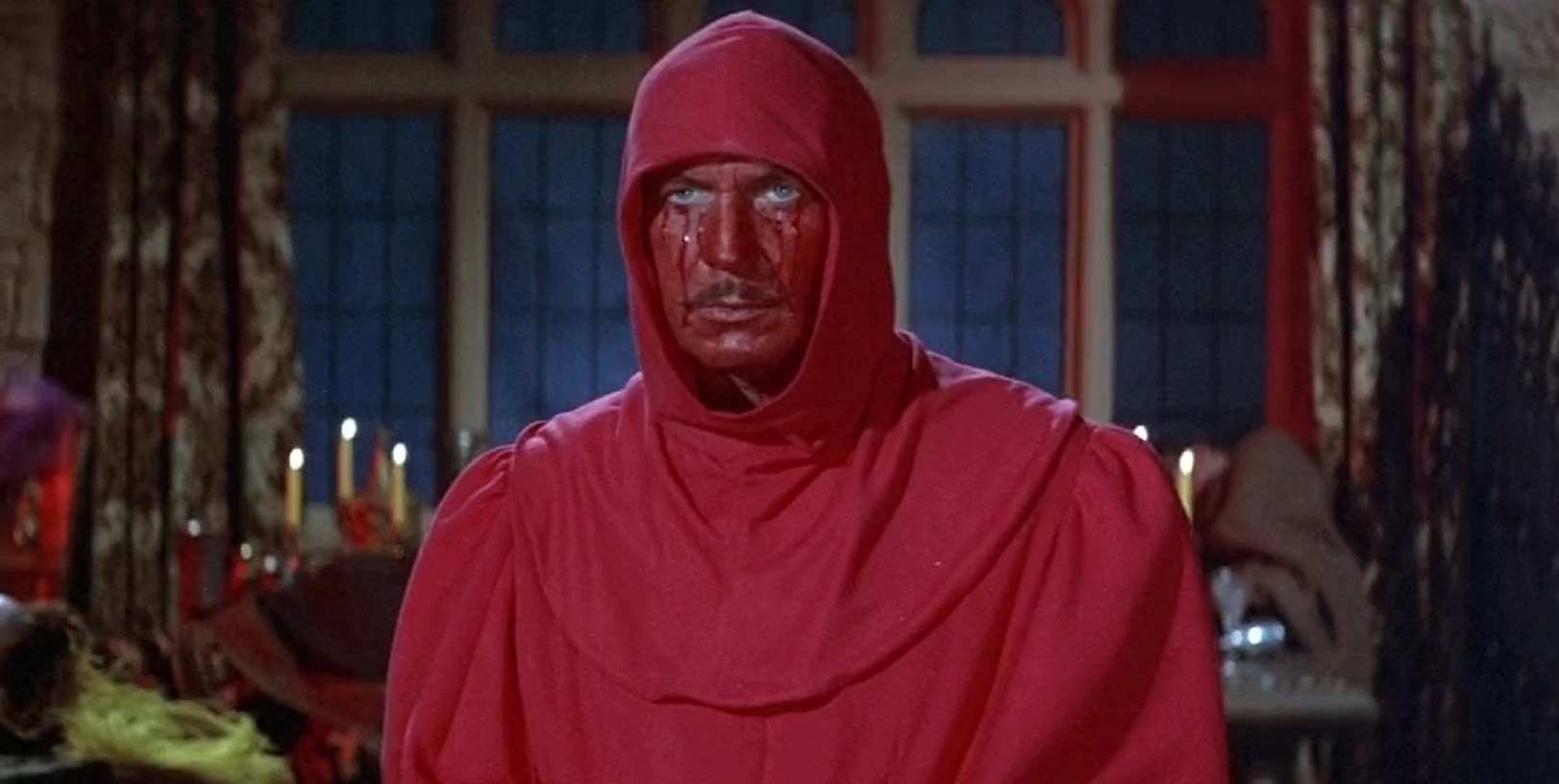
Lars von Trier’s Epidemic (1987) has an amusing ending where von Trier, playing a filmmaker, decides to get around making a film by hypnotically regressing actors to Mediaeval times, only for a subject to carry the plague back to the modern day.
The thriller Have Mercy On Us All/Seeds of Death (2007) had a classics scholar creating a new outbreak of bubonic plague as part of a revenge scheme. Nightwing (1979) features an outbreak of bubonic plague on an American Indian reservation carried by infected vampire bats.
Recent years has seen fears of real-life plagues such as the Avian Bird Flu, which has appeared in the odd film like Postal (2007) where terrorists attempt to release it, and Flu Bird Horror (2008) in which it actually mutates birds.
The Corona Virus Pandemic
The Corona Virus or Covid-19 epidemic of 2020 has had such vast effect and socially devastating consequences around the world that it is likely to become the subject matter of a great many films – watch this space.
The Corona Virus epidemic was first dealt with in Charles Band’s cheap Corona Zombies (2020) where it creates zombies. An unusual effort was Before the Fire (2020) released just before the pandemic was officially announced by the WHO, which predicts a pandemic sweeping the USA.
Anthropocene (2020), Breakdown (2020), Songbird (2020), Lockdown 2025 (2021) and The Survivalist (2021) are set several years on. These either predict futures where the virus has as the pandemic has caused social collapse, has become even more virulent and/or extreme conditions have been imposed to deal with it, frequently requiring that the infected be herded into quarantine zones.
2025: The World Enslaved by a Virus (2021) was a Christian film where the pandemic has been the opportunity for the imposition of worldwide Communist state and the outlawing of meetings, travel and Christianity. Coronavirus Conspiracy: Safer at Home (2021) is a comedy that reveals that humanity has been uploaded into a computer simulation by monkey overlords – there the virus is merely one of a host of scenarios they are testing out on humanity.
House of Quarantine (2020) is about the tensions that emerge among a film crew trapped in a house during lockdown that eventually erupt into violence and murder and Shelter in Place (2021) with a couple trapped in a hotel during lockdown amid sinister happenings. In The Lockdown Hauntings (2021), the isolation of lockdown brings the release of supernatural entities.
Scenes from an Empty Church (2021) is a nicely upbeat film about two Catholic priests trying to keep their church open and offer succour during the pandemic. The Covid Killer (2021) concerns a serial killer operating during the lockdown.
Of note was Isolation (2021), an anthology of eight stories all shot during lockdown by ten different directors, in many cases in their own homes and using themselves and family members as cast.
Covid 21: Lethal Virus (2021) is merely the name given to a deadly outbreak of prehistoric rabies.
Biowarfare Agents
Probably the first film to deal with bacteriological terrorism was The Whip Hand (1951) about a Communist plot to unleash germ warfare inside America. There are numerous thrillers concerning spills of biowarfare agents and the race to prevent their spread including Plague/M3: The Gemini Strain (1978), Contaminated Man (2000) and the anime Cowboy Bebop: The Movie (2001).
Several techno-thriller and action films use bio-weapons as a McGuffin. The first of these was The Satan Bug (1965) about a mad billionaire engineering the theft of a deadly virus from a germ warfare lab and threatening to unleash it. Other films in a similar vein include The New Avengers episode The Midas Touch (1976), Shaker Run (1985), Chill Factor (1999), Mission: Impossible II (2000), The Tuxedo (2002), Lara Croft, Tomb Raider: The Cradle of Life (2003), Mission: Impossible III (2006), Stormbreaker (2006), L: Change the World (2008) and Inferno (2016). All of these are thrillers and action centred around the theft of biological agents and preventing their use and do not depict actual outbreaks.

Super-Villains frequently seek to employ bio-warfare threats. The James Bond films On Her Majesty’s Secret Service (1969) had the super-villain Blofeld infecting girls with deadly germs to go and kill world leaders, while Moonraker (1979) has a villain building a space station peopled with his master race and preparing to eliminate the world’s population via toxins so that he can repopulate it with his chosen few. The X Files (1998) features a sinister cabal seeking to exploit the discovery of a prehistoric alien virus.
In the realm of the bizarre was Hammer’s The Satanic Rites of Dracula (1973) where Christopher Lee’s Dracula is trying to unleash a plague to kill the world off and bring about his own death. In Carnosaur (1993), mad scientist Diane Ladd infects eggs with a genetically engineered virus that causes women to give birth to dinosaurs.
A comedy variant was the Stink Bomb episode of the anime anthology Memories (1995) where a lab technician takes what he believes to be a cold pill that turn out to be a deadly toxin that kills everybody in the area and destroys all equipment that the military try to use to stop him. In Casino Royale (1967), Woody Allen hatches a plan to unleash a virus that will kill off all men in the world over the height of 4’6”.
Zombie Outbreaks
In the Zombie Film, viral and biowarfare releases are frequently the cause of zombie outbreaks. Night of the Living Dead (1968), which created the modern zombie film, implies the zombie apocalypse of caused by infection from a returned Venus probe.
Other examples in the zombie film include Return of the Living Dead (1985) and sequels, Resident Evil (2002) and sequels, 28 Days Later (2002) and sequel, Dead Meat (2004), Day of the Dead 2: Contagium (2005), I Am Omega (2007), Day of the Dead (2008), Against the Dark (2009), Horrid (2009), Bloodlust Zombies (2011), Undertaker (2012), Antisocial (2013),Infected (2013), Word War Z (2013), Night of the Living Deb (2015), The Scorch Trials (2015), Here Alone (2016), Pandemic (2016), Viral (2016), Patient Zero (2018), Corona Zombies (2020) and Forget Everything and Run (2021)..
In [Rec] (2007) and sequels and its English-language remake Quarantine (2008), demonic possession leads to a zombie-like contagion outbreak in an apartment building. The Danish Possessed (1999) had a virologist obsessively following the path of a virus, only to discover he is dealing with a series of cases of possession by The Devil.

The standout among these was Pontypool (2008) that takes place at a radio station and concerns people being turned into zombies by a plague that resides in the English language. The Italian gore film Cannibal Apocalypse/Cannibals in the Streets (1980) concerns a virus that drives Vietnam Veterans to cannibalism.
Alien Cargo (1999) is set aboard a spaceship where an alien virus is turning the remaining crew paranoid and psychopathic. Splinter (2008) deals with infection by deadly plants. The Invasion (2007) is a remake of Invasion of the Body Snatchers (1956) where the pods are replaced by a biological infection.
The Last Man on Earth (1964), the only faithful version of Richard Matheson’s I Am Legend (1954), concerns the titular last man at siege from hordes of vampires created by biowarfare. These are replaced by mutants in The Omega Man (1971) and I Am Legend (2007). Vampire Virus (2020) treats vampirism as a deadly viral infection, while plague creates a race of vampire-like mutants in Ultraviolet (2006). Hidden (2015) takes place in a fallout shelter as a family huddle from an infection above that has created mutants.
Other Plague Outbreaks
George A. Romero’s underrated The Crazies (1973) created the theme of a biospill sending the population of a small town crazy. In a similar vein, there was also the modestly effective Impulse (1984) about a town being driven crazy by a toxic biospill. The idea of a madness-inducing contagion features in other films like Warning Sign (1985), Dead Air (2009), Salvage (2009), The Collapsed (2011), Patient Zero (2012), Mayhem (2017), Mom & Dad (2017) and The Sadness (2021) These are dealt with in more detail under the theme Films About Mass Insanity.
The excellent Blindness (2008) concerns itself a plague that has sudden catastrophic social consequences when it turns everybody blind. Perfect Sense (2011) concerns a plague that causes people to gradually lose all of their senses; The Last Days (2013) concerns a worldwide plague of agoraphobia; Truth (2014) concerns a biowarfare infection that leaves people unable to lie; while Apples (2020) and Little Fish (2020) concerned a plague of amnesia.
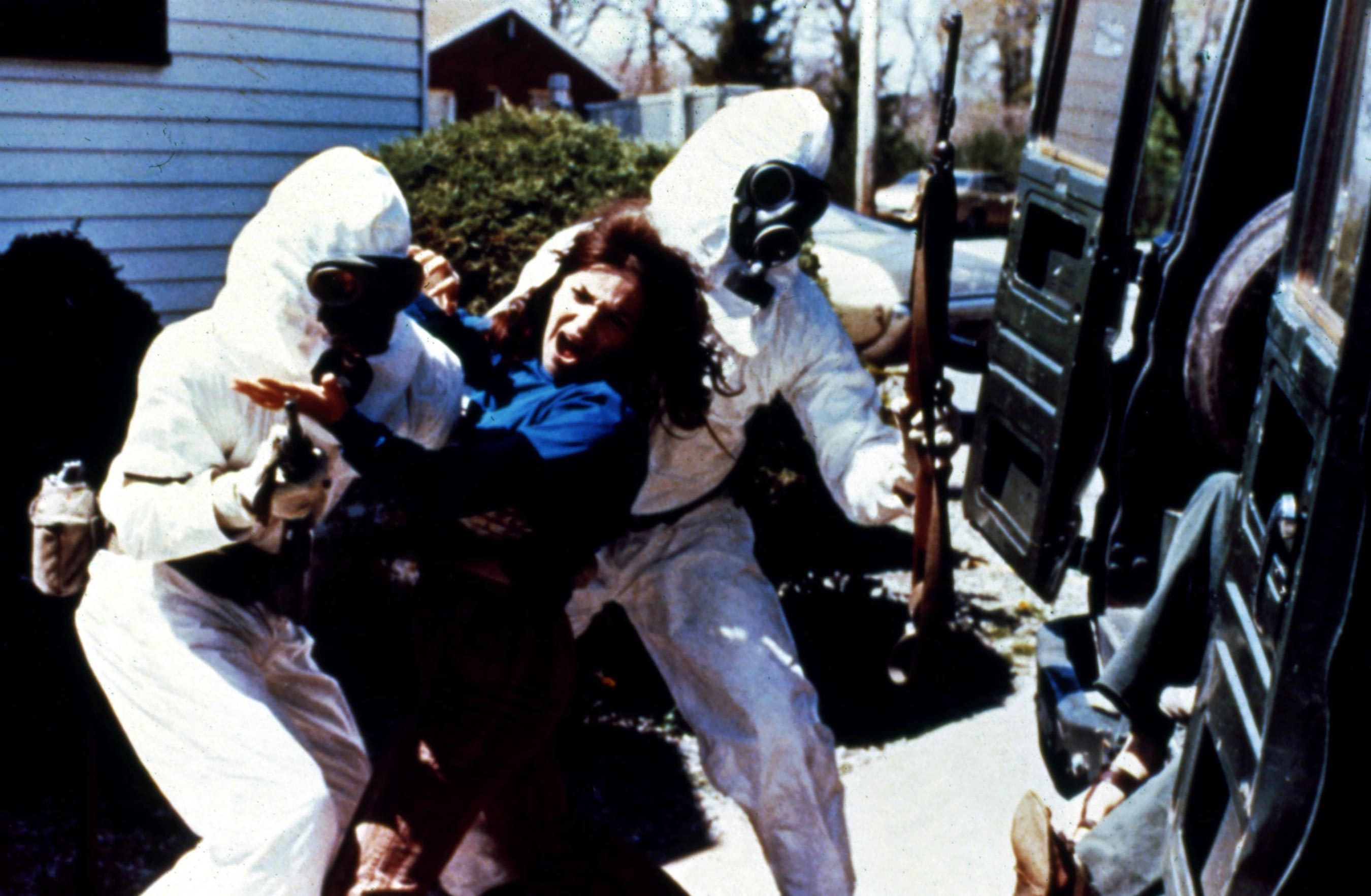
Leos Carax’s Mauvais Sang (1986) is about a plague that causes people to have sex without love, while Thomas Vinterberg’s It’s All About Love (2003) concerns a plague of loneliness. The strange Taiwanese art film The Hole (1998) concerns a plague that causes people to lock themselves away in darkness.
The comedy What’s So Bad About Feeling Good? (1968) concerned the release of a virus that suddenly made everybody happy. The Family Complete (2010) concerns an infection that causes incest. In the British sex comedy Percy’s Progress (1974), an accidental biospill renders all men on Earth impotent.
Other outbreaks occur in films like Rabid (1977) where an experimental skin graft causes a blood-sucking growth to emerge on a woman’s arm and infects all it drinks from. There’s even a fake outbreak in Close Encounters of the Third Kind (1977) and the Korean monster movie The Host (2006), while in Mimic (1997) genetically engineered insects are created to cure a plague, only for the insects to evolve. The Star Trek: Deep Space Nine episode The Quickening (1996) deals with the attempts to fight a plague infecting an alien planet.
Recommendations
- Isle of the Dead (1945)
- The Masque of the Red Death (1964)
- The Satan Bug (1965)
- The Andromeda Strain (1971)
- The Crazies (1973)
- Survivors (tv series, 1975-7)
- The Navigator: A Mediaeval Odyssey (1988)
- Memories (1995)
- Outbreak (1995)
- [Rec] (2007)
- Blindness (2008)
- Pontypool (2008)
- Carriers (2009)
- Black Death (2010)
- Contagion (2011)
- Perfect Sense (2011)
- The Bar (2017)
- Mayhem (2017)
- The Hot Zone (tv mini-series, 2019)
- Light of My Life (2019)
- Little Fish (2020)
A full list of titles can be found here Films About Plague and Pandemic
